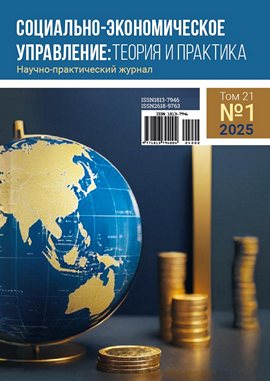POPULATION SETTLEMENT TRENDS AND DEMOGRAPHIC PROBLEMS OF UDMURTIA
DOI:
https://doi.org/10.22213/2618-9763-2025-1-5-17Keywords:
design of LSZHN, local vital activity systems of the population (LSZHN), district settlement systems, Izhevsk agglomeration, demographic situation, economic base of settlement, population settlement systemAbstract
The content of the concept of “settlement system” is revealed as a complex socio-economic-demographic system, including: 1) an economic base represented by a set of enterprises, organizations and institutions of all forms of ownership and 2) the population itself as an independent biosocial reproductive subsystem. A cause-and-effect relationship between the development of the economic base and the economic and demographic situation has been identified: the more developed the economic base, the more attractive the settlement is for the population and vice versa. The poor development of the economic base in most settlements of Udmurtia, especially in rural areas, is the reason for the outflow of the population from the village and the reduction of rural settlements. Depopulation of the population is observed throughout Udmurtia as a whole, which indicates an unfavorable socio-demographic situation in the region. In addition to low birth rates and high mortality rates, there is a tendency for the rural population to move to regional centers, cities and the regional capital. The identification of three structural parts within the regional settlement system of Udmurtia is justified: Izhevsk agglomeration; 24 district settlement systems; more than 300 local vital activity systems (LSPS). A description of the identified parts of the settlement is given. The structure of LSZHN is presented in the form of 4 interconnected sections: 1) basic human needs, as target guidelines for the formation and development of LSZHN; 2) local population settlement system and demographic situation in the territory; 3) the state of the economic base; 4) resources of the territory. The issue of designing LSZHN is considered, which, according to the author, is the basis for comprehensive socio-economic planning for the development of the territory. In the planning process, it is necessary to achieve full employment and comprehensive development of the social and living sphere of LSZHN.References
Tomaney J., Ward N. England and the 'new regionalism' // Regional Studies. 2000. Vol. 34.5. Pp. 471-478.
Осипов А. К., Гайнутдинова Е. А., Кондратьев Д. В. Совершенствование управления сельскими территориями // Фундаментальные исследования. 2021. № 6. С. 70-74. DOI: 10.17513/fr.43060. EDN: FMWUBA
Проблемы реализации социально-демографической и семейной политики в регионе (по материалам Удмуртской Республики): монография / А. К. Осипов, Ю. К. Никитина, Е. А. Гайнутдинова, И. А. Мухина. Ижевск: Шелест, 2019. 159 с. EDN: PEXXFX
Тенденции и проблемы развития сельских территорий (по материалам Удмуртской Республики): коллективная монография / А. К. Осипов, О. Ю. Абашева, П. Б. Акмаров; под науч. ред. А. К. Осипова. Ижевск: Шелест, 2023, с. 363. EDN: CCGKEB
Осипов А. К., Гайнутдинова Е. А., Кондратьев Д. В. Совершенствование управления сельскими территориями // Фундаментальные исследования. 2021. № 6. С. 70-74. DOI: 10.17513/fr.43060. EDN: FMWUBA
Удмуртия в цифрах. 2021 год: стат. ежегод. Ижевск: Удмуртстат, 2022. 357 с.
Миронова Е. А., Переверзин С. Н., Яковлева П. А. Социально-экономическое положение муниципальных образований Удмуртской Республики: стат. сб. Ижевск: Удмуртстат, 2022. 200 с.
Тугуз Ф. В. Эволюция систем расселения на территории современной Республики Адыгея // Вестник Адыгейского государственного университета. Серия 4: Естественно-математические и технические науки. 2018. № 1 (216). С. 91-97. EDN: XPHUWD
Tomaney J., Ward N. England and the 'new regionalism' // Regional Studies. 2000. Vol. 34.5. Pp. 471-478.
Тенденции и проблемы развития сельских территорий (по материалам Удмуртской Республики): коллективная монография / А. К. Осипов, О. Ю. Абашева, П. Б. Акмаров; под науч. ред. А. К. Осипова. Ижевск: Шелест, 2023, с. 363. EDN: CCGKEB
Radstrom S. A. Place Sustaining framework for local urban identity: An introduction and history of Cittaslow // IJPP (Italian Journal of Planning Practice): a fully open access academic journal. 2011. Vol. I, is. 1. P. 90-113.
Вызовы и политика пространственного развития России в XXI веке: монография / Л. Б. Вардомский, О. Б. Глезер, Р. В. Гончаров [и др.].; ред. В. М. Котляков, А. Н. Швецов, О. Б. Глезер. Москва: Товарищество научных изданий КМК, 2020. 365 с. ISBN: 978-5-907213-39-5. EDN: OXAOXI
Моргунов Е. В., Шутов О. Л., Фатуллаев С. Т. Теоретико-методологические подходы к определению городской агломерации как пространственно-локализованной подсистемы российских регионов // Вестник МИРБИС. 2021. № 3 (27). С. 28-36. DOI: 10.25634/MIRBIS.2021.3.3. EDN: GWRQGW
Милашевская А. Н. Принципы развития системы расселения в работах французских авторов // Architecture and Modern Information Technologies. 2022. №. 4 (61). С. 239-255. DOI: 10.24412/1998-4839-2022-4-239-255
Короленко А. В. Трансформация системы расселения и ее демографические проявления: опыт исследования на региональном и муниципальном уровне // Экономические и социальные перемены: факты, тенденции, прогноз. 2023. Т. 16. № 2. С. 127-148. DOI: 10.15838/esc.2023.2.86.7
Короленко А. В. Пространственные трансформации территорий России: тенденции и региональные различия расселения // Проблемы развития территории. 2023. Т. 27. № 1. С. 47-75. DOI: 10.15838/ ptd.2023.1.123.4
Егоров Д. О. Пространственное сжатие и поляризация сельского пространства Республики Татарстан на фоне депопуляции населения // Региональные исследования. 2020. № 4. С. 32-45. DOI: 10.5922/1994-5280-2020-4-3. EDN: VIXXTD
Глезер О. Б., Вайнберг Э. И. Пространство жизнедеятельности населения и расселение как факторы и условия модернизации России // Регион: экономика и социология. 2013. № 3. С. 21-38. EDN: QZRTUR
Downloads
Published
How to Cite
Issue
Section
License
Copyright (c) 2025 А К Осипов

This work is licensed under a Creative Commons Attribution 4.0 International License.


